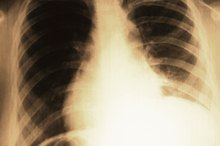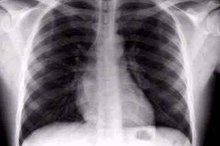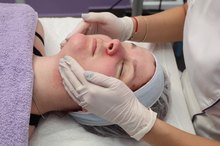What Is Perihilar Scarring of the Lungs?
Lung scarring can be a highly dangerous condition and is usually caused by inhaling dangerous chemicals or by infections. Lung scarring is generally defined by which area of the lung is injured, with the perihilar area, which is the major entry way for the major veins and arteries of the lungs, being the most common.
What is the Perihilar?
"Perihilar" is a tern designates the area of the lung around the hilum, a triangular depression where the major arteries and airways enter and leave the rest of the lung. These include the bronchus, the main passageway bringing air into the lungs, and the main pulmonary veins and arteries. The perihilar area is the most likely to scar, due to being the main area receiving air and thus receiving the most particulate and other matter.
Causes of Perihilar Scarring
Atelectasis Vs. Scarring
Learn More
Perihilar scarring can be caused by prior infections, such as pneumonia, inhaling particulates such as asbestos or silicates, inflammatory diseases such as sarcoidosis or hereditary diseases such as cystic fibrosis. It can be aggravated by environmental and health factors, most prominently smoking or working in a fume-heavy environment. The lung, however, is fairly resilient and small scars will not cause any long-term damage. Most scars will calcify and remain after the injury is inflicted.
Symptoms and Diagnosis
Possible symptoms of perihilar lung scarring include persistent cough, shortness of breath and lower energy levels. The side effects of lung scarring also can resemble viral infections and common illnesses, with symptoms such as night sweats, fever or chills. It is generally diagnosed by comparing old patient X-ray with newer ones or, in some cases, with a brachiotomy, in which a camera is placed into the patient's respiratory tract, and it looks around for any signs of scarring.
Treatments
What Causes Scarring of the Lungs?
Learn More
There are few treatments for perihilar lung scarring currently available. Generally, lung scars do not impede the function of the lung enough to risk exploratory surgery to remove the calcified scars. If the scars are widespread enough, it will be diagnosed as pulmonary fibrosis and oral steroids are administered. If oral steroids fail to improve lung function, a lung transplant may be considered. However, depending on the transplant, this may not address perihilar scarring.
Prevention
Preventing perihilar scarring is a fairly simple process. If working with particulates, always wear a respirator and other safety gear. Do not smoke, or if you do smoke, quit. Have regular physicals, including measurements of lung function, to ensure you have no infections. Examine your family history to rule out any hereditary diseases that may cause scarring, and inform your doctor of any discoveries. Always follow doctor's orders, and you may have healthy lung function for life.
Related Articles
References
Writer Bio
Dan Seitz has been writing professionally since 2008. He has been published on Cracked.com, Spike.com, AMOG.com, OverthinkingIt.com, Zug.com, TheDeadbeat.com and Gunaxin.com. He holds a Bachelor of Arts in theater and is currently earning his Master of Arts in film at Emerson College.








